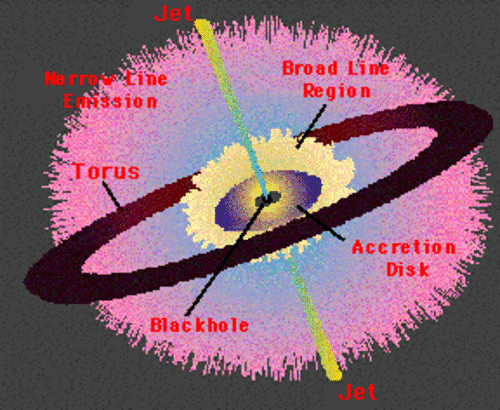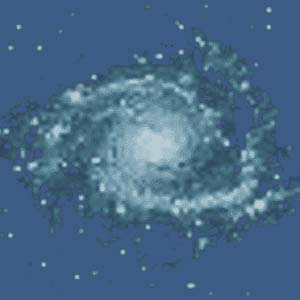| In contrast to the 'normal' galaxies, active galaxies
are characterized by the presence of an extremely bright nucleus, which
dominates over the emission of the surrounding stars. The luminosity of
an active galactic nucleus (AGN) ranges from 1041 to 1047
erg /s, reaching even 1048 erg /s for the brightest quasars.
Since their rapid variability implies that the majority of emission originates
in a very small region, the most plausible explanation of this unusual
amount of energy powering AGN is the accretion of gas onto a supermassive
black hole.
 *
Two classes of Seyfert galaxies *
Two classes of Seyfert galaxies
Characteristic feature of the AGN spectra is the
presence of various emission lines. Among these the two distinct groups
are observed: broad, permitted emission lines (FWHM in the range 1500 -
30000 km /s) and narrow emission lines (FWHM < 900 km /s), which may
be either permitted or forbidden. The lines are produced in two separate
regions, Narrow Line Region (NLR) and Broad Line Region (BLR), and as it
is assumed in the currently accepted unification scheme of Syfert 1 and
Seyfert 2 galaxies, BLR lies much closer to the central engine, being in
Seyfert 2 galaxies obscured by a thick, molecular torus. Thus the orientation
effects are the cause of the observed differences between these two types
of Seyferts.
 *
Spectra of AGN *
Spectra of AGN
The spectra of AGN extend over several decades
of energy, from radio to X-ray and Gamma-ray bands.
The picture (Laor et al., 1997, ApJ, 477, 93) shows the composite spectral
energy distribution of a sample of quasars. The bolometric luminosity
is dominated however by the ultraviolet emission, which has a form of the
so called Big Blue Bump. This component comes from the accretion disk.
Above 1 keV the X-ray spectrum has a power law shape, which in logarithmic
plot has a form of a straight line. This hard X-ray tail is formed due
to Compton upscattering of soft photons in a hot plasma outside the accretion
disk. Many AGN exhibit also the reflection component and fluorescent iron
line, which both originate form the 'reflection' of hard X-rays from a
cold 'mirror' - accretion disk. Additionally, in most sources the observations
reveal an excess of emission above the extrapolated power law in the soft
X-ray band. The origin of this 'Soft Excess' is not yet confirmed, mainly
because any interpretation relies on extrapolating the spectrum through
the XUV band, which is not observable due to the Galactic absorption.
|

















